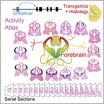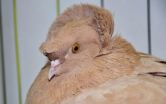(Press-News.org) For social animals such as schooling fish, the loss of their numbers to human activity could eventually threaten entire populations, according to a finding that such animals rely heavily on grouping to effectively navigate their environment.
Princeton University researchers report in the journal Science that collective intelligence is vital to certain animals' ability to evaluate and respond to their environment. Conducted on fish, the research demonstrated that small groups and individuals become disoriented in complex, changing environments. However, as group size is increased, the fish suddenly became highly responsive to their surroundings.
These results should prompt a close examination of how endangered group or herd animals are preserved and managed, said senior researcher Iain Couzin, a Princeton professor of ecology and evolutionary biology. If wild animals depend on collective intelligence for migration, breeding and locating essential resources, they could be imperiled by any activity that diminishes or divides the group, such as overhunting and habitat loss, he explained.
"Processes that increase group fragmentation or reduce population density may initially appear to have little influence, yet a further reduction in group size may suddenly and dramatically impact the capacity of a species to respond effectively to their environment," Couzin said. "If the mechanism we observed is found to be widespread, then we need to be aware of tipping points that could result in the sudden collapse of migratory species."
The work is among the first to experimentally explain the extent to which collective intelligence improves awareness of complex environments, the researchers write. Collective intelligence is an established advantage of groups, including humans. As it's understood, a group of individuals gain an advantage by pooling imperfect estimates with those around them, which more or less "averages" single experiences into surprisingly accurate common knowledge. For instance, the paper in Science cites a 1907 study that predicted with near precision the weight of an ox based on the estimates of 787 people.
With their work, Couzin and his coauthors uncovered an additional layer to understanding collective intelligence. The conventional view assumes that individual group members have some level of knowledge albeit incomplete. Yet the Princeton researchers found that in some cases individuals have no ability to estimate how a problem needs to be solved, while the group as a whole can find a solution through their social interactions. Moreover, they found that the more numerous the neighbors, the richer the individual — and thus group — knowledge is.
These findings correlate with recent research showing that collective intelligence — even in humans — can rely less on the intelligence of each group member than on the effectiveness of their communal interaction, Couzin said. In humans, research suggests that such cooperation would take the form of open and equal communication among individuals regardless of their respective smarts, he said.
The researchers placed fish known as golden shiners in experimental tanks in groups as low as one and as high as 256. The tanks featured a moving light field that was bright on the outer edges and tapered into a dark center. To reflect the changing nature of natural environments, they also incorporated small patches of darkness that moved around randomly. Prolific schoolers and enthusiasts of darkness, the golden shiners would pursue the shaded areas as the researchers recorded their movement using computer vision software. Although the fish sought the shade regardless of group size, their capability to do so increased dramatically once groups spanned a large enough area.
The researchers then tracked the motion of individual fish to gauge the role of social influence on their movement. They found that individuals adjusted their speed according to local light level by moving faster in more brightly lit areas, but without social influence the fish did not necessarily turn toward the darker regions. Groups, however, readily swam to dark areas and were able to track those preferred regions as they moved.
This collective sensing emerged due to the coherent nature of social interactions, the authors report. As one side of the group slowed and turned toward the shaded area, the other members did as well. Also, slowing down increased density and resulted in darker regions becoming more attractive to these social animals.
###
Couzin worked with lead authors Andrew Berdahl, a Princeton graduate student, and postdoctoral fellow Colin Torney, both currently in Couzin's lab, as well as with former lab members Christos Ioannou and Jolyon Faria, who are now at the University of Bristol and the University of Oxford, respectively.
The paper, "Emergent sensing of complex environments by mobile animal groups," was published online Jan. 31 by Science. The work was supported in part by grants from the National Science Foundation, the U.S. Office of Naval Research, the U.S. Army Research Office and the Natural Sciences and Engineering Research Council of Canada.
The effective collective: Grouping could ensure animals find their way in a changing environment
2013-02-01
ELSE PRESS RELEASES FROM THIS DATE:
Evidence of geological 'facelift' in the Appalachians
2013-02-01
How does a mountain range maintain its youthful, rugged appearance after 200 million years without tectonic activity? Try a geological facelift – courtesy of the earth's mantle.
Researchers from North Carolina State University noticed that a portion of the Appalachian Mountains in western North Carolina near the Cullasaja River basin was topographically quite different from its surroundings. They found two distinct landscapes in the basin: an upper portion with gentle, rounded hills, where the average distance from valley to mountain top was about 500 feet; and a lower ...
Genome-wide atlas of gene enhancers in the brain online
2013-02-01
Future research into the underlying causes of neurological disorders such as autism, epilepsy and schizophrenia, should greatly benefit from a first-of-its-kind atlas of gene-enhancers in the cerebrum (telencephalon). This new atlas, developed by a team led by researchers with the U.S. Department of Energy (DOE)'s Lawrence Berkeley National Laboratory (Berkeley Lab) is a publicly accessible Web-based collection of data that identifies and locates thousands of gene-regulating elements in a region of the brain that is of critical importance for cognition, motor functions ...
New role for DNA methylation in subset of premature aging disorder patients
2013-02-01
Scientists at the Bellvitge Biomedical Research Institute in Barcelona, Spain have found new evidence for the role of epigenetic changes (those heritable alterations in gene expression caused by mechanisms other than changes in DNA sequence) on premature aging diseases. A new study published in the journal Epigenetics on Jan. 1, 2013, identified a role for DNA methylation changes in a subset of Hutchinson-Gilford Progeria and Werner Syndrome patients, for which no genetic cause (such as DNA mutation) had been associated with onset disease. The study, titled "Aberrant DNA ...
Safe sex practices among African American women
2013-02-01
Los Angeles, CA (January 31, 2013) Researchers have found that African American women exhibit a higher risk for sexually transmitted infections including HIV/Aids. But what motivates this group of women to have sex? And when are they more likely to use protection?
A new study published today in Health Education & Behavior (a SAGE journal) found that regardless of motivations for having sex, condom use expectations were less than 50% for all types of sexual encounters, including the riskiest types of sex.
Researchers Julianna Deardorff et. al used a combination of interviews ...
Men taking long-acting chronic pain meds 5xs more likely to have low testosterone levels
2013-02-01
OAKLAND, Calif., January 31, 2013 — Low testosterone levels occur five times more often among men who take long-acting instead of short-acting opioids for chronic pain, according to a new Kaiser Permanente study published in The Clinical Journal of Pain.
While it has been known that opioids cause low testosterone in men, this study is the first to show a significant difference in risk between short-acting (immediate release) and long-acting opioids.
The 81 men in the retrospective study were between 26 and 79 years old (median age 51) and were seen in the chronic-pain ...
New device traps particulates, kills airborne pathogens
2013-02-01
A new device called a soft x-ray electrostatic precipitator protected immunocompromised mice from airborne pathogenic bacteria, viruses, ultrafine particles, and allergens, according to a paper published online ahead of print in the journal Applied and Environmental Microbiology. This device, known for short as a SXC ESP, is highly versatile, with multiple potential uses, and Washington University is working on licensing the technology.
"Small particles are difficult to remove, and our device overcomes that barrier," says Pratim Biswas of Washington University, St. Louis. ...
Mutant gene responsible for pigeons' head crests
2013-02-01
Scientists have decoded the genetic blueprint of the rock pigeon, unlocking secrets about pigeons' Middle East origins, feral pigeons' kinship with escaped racing birds and how mutations give pigeons traits like feather head crests.
"Birds are a huge part of life on Earth, but we know surprisingly little about their genetics," says Michael Shapiro, one of the study's two principal authors and a biologist at the University of Utah.
In the new study, "we've shown a way forward to find the genetic basis of traits--the molecular mechanisms controlling animal diversity in ...
Just 11 percent of adults, 5 percent of children participate in medical research
2013-02-01
ANN ARBOR, Mich. – Medical research is vital to the advancement of health care, but many medical research studies have too few people who participate. A new study from the University of Michigan takes an in-depth look at public participation in medical research across the United States.
Through a unique, nationally representative survey of 2,150 households in 2011, University of Michigan researchers found that only 11% of adults and 5% of children had ever participated in medical research. The study was published in January in Clinical and Translational Science.
About ...
2-step immunotherapy attacks advanced ovarian cancer
2013-02-01
PHILADELPHIA -- Most ovarian cancer patients are diagnosed with late stage disease that is unresponsive to existing therapies. In a new study, researchers from the Perelman School of Medicine at the University of Pennsylvania School of Medicine show that a two-step personalized immunotherapy treatment — a dendritic cell vaccine using patients' own tumor followed by adoptive T cell therapy — triggers anti-tumor immune responses in these type of patients. Four of the six patients treated in the trial responded to the therapy, the investigators report this month in OncoImmunology. ...
Nurses at forefront of genomics in healthcare
2013-02-01
On April 14, 2003 a map of the human genome was completed, ushering in a new era of genetics in medicine with applications that include genetic testing; newborn screening; susceptibility to diseases such as cancer, cardiovascular disease, or psychiatric conditions; screening, diagnosis and monitoring of disease; and treatment planning. A special Genomics Issue, including an evidence review by researchers from the National Institutes of Health (NIH), published by Wiley in the Journal of Nursing Scholarship on behalf of the Honor Society of Nursing, Sigma Theta Tau International, ...


